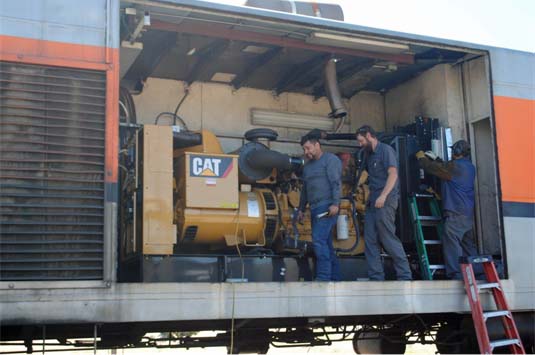Generator Configurations
Generator sets are manufactured in many configurations to satisfy customer needs. The most common configurations are:
Skid Mounted Unit
Located in under roof or indoor applications. Engine, generator and cooling system mounted on a skid. External exhaust and fuel supply are required for this unit.
Canopy
Used for permanent installations. Engine, generator, control and cooling system are installed into an enclosure. This allows for components to be isolated from weather and offers environmental heat and noise reduction. Manufacturers offer fuel tank additions.
Mobile Unit
Engine, generator, control, and cooling systems located into a trailer. Trailer sizes vary with generator sizes. Mobile units are often used in construction fields when constant power supply has not been established.
Generator Set Installation
WARNING
To reduce the possibility of personal injury or equipment, only use lifting devices approved for weight of generator sets. When connecting a generator to automatic transfer switch use tag out lock out procedures for all equipment. Working on energized equipment can cause personal injury or death.
All generator set configurations must be located and installed correctly to provide for safe and efficient operation. Some standard rules for locating generator sets are:
Skid Mounted Unit
Units must be set on solid, level surface capable of supporting generator set during operation. When placing unit, an approved lifting apparatus (fork truck or crane) must be used. Automatic transfer switch sizing, and conductor sizing must meet NEC standards. Fuel is supplied from remote location (diesel or natural gas). Exhaust must be insulated and routed out of building to atmosphere.
Canopy Unit
Located appropriate distance from structures. Fuel tank is located in close approximation of unit and protected from damage during fueling operation. Approved lifting device is used to set unit and fuel tank. Electrical cable often located in underground conduit. Automatic transfer switch (commonly located in switch room) and conductor sizing must meet NEC standards. Unit houses generator control panel but can have remote panel located in switch room.
Mobile Unit
Unit must be located on solid surface and leveled. Mobile units are completely self-contained and can be transported with fluids. Temporary Cable must be located out of traffic area. Generator can be connected to automatic transfer switch or load using an approved manufacturer’s plug or using individual electrical lugs that connected to terminals.
Generator Startup
When the generator is ready for start-up and load manufacturer’s recommendations must be followed for the unit. Remove all tags and locks from equipment installed during connection. Permanent units are shipped without fluids, while mobile units can be shipped with all fluids.
Basic rule of thumb checks for start-up operations for mobile units are:
1. Verify all electrical connections are correctly connected and tight.
2. Check fuel, oil and coolant levels. Verify air filter indicator is in green and operable.
3. Start engine and check for fuel, oil, exhaust leaks and louver operation.
4. Make sure no engine or generator alarms exist.
5. Load generator set and make sure all operating parameters are correct.
Basic rule of thumb checks for start-up operations of permanent units are:
1. Verify all electrical connections are correctly connected and tight.
2. Fill engine with oil, coolant tank with coolant, fill fuel tank with fuel.
3. Verify fuel line is connected from fuel tank to engine.
4. Verify air filter indicator is green and operable.
5. Prime fuel system (engine fuel systems without automatic prime functions).
6. Start engine, check for fuel, oil and exhaust leaks. Make sure no engine or generator alarms exist.
7. For canopy unit installations, check louver operation.
8. Run engine until operating temperature is reached and shutdown.
9. After engine cools down, check and oil level and coolant level. Add fluid where needed.
10. Load generator set and make sure all operating parameters are correct.
Operating and Refueling Generator Sets
WARNING
Fuel vapors are flammable. To prevent the possibility of personal injury and death, never fuel a generator that is in operation. To prevent the possibility of personal injury, appropriate personal protective equipment (PPE) must be used when inspecting functioning generator sets.
All generator set manufacturers recommend checks to be performed when the generator is in stand-by mode and when the generator is operating under loaded conditions. Stand-by mode checks can include fluid checks and loading of generator at given times such as monthly. While running checks can include:
• Monitor generator panel for alarm and parameters.
• Check for fuel level on tank sight glass.
• Check for fuel, coolant, oil and exhaust leaks.
• Make sure all louvers are open during operation.
CAUTION
To reduce the possibility power loss because of engine shutdown due of lack fuel, calculate refueling times. Schedule power requirements with fueling schedules. Fuel systems may need to be manually primed extending down time.
Facilities that have critical emergency power requirements can use natural gas supplied generator sets. This allows fuel supply that is limited by utilities only. All basic maintenance checks are performed on these units when in standby and running modes.
Fuel usage tables have been established for each generator unit. Once the generator has been connected to load, calculate the percent of capable load (25/50/75/100%). Use the table to determine when the unit will need to be refueled. Common refueling practices for canopy and mobile unit generators are:
• Remove generator from power grid.
• Shutdown generator and allow engine to cool.
• Refuel fuel tank.
• Start and load generator.
Moving Mobile Generator Sets
In some cases it may be necessary to change generator set locations on a site. When changing the location a generator set consider the following:
• Reduce the amount of moves by positioning generator in a location accessible by multiple locations.
• Inform all users of loss of power due to generator move.
• Always disconnect from power grid prior to shutdown.
• Locate on solid level ground.
• Route power cable out of high traffic areas.
• Connect cable to generator and automatic transfer switch.
• Start and load generator.
|